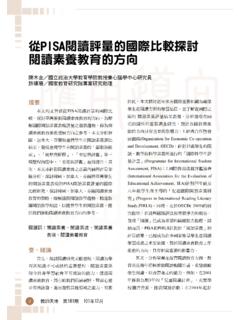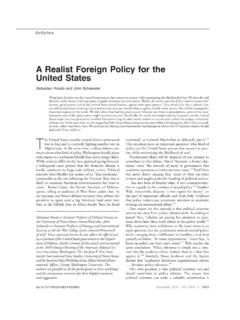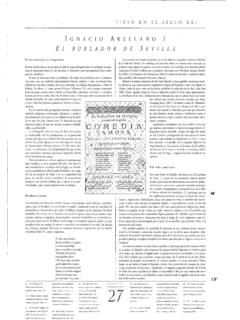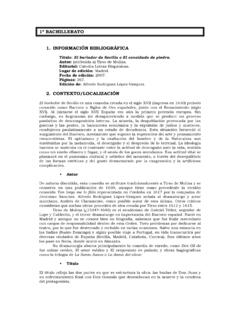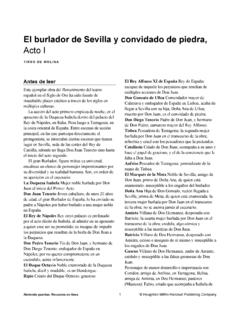Transcription of I. The Myth of Don Juan - National Chengchi …
1 1 THE ROGUE (TRICKSTER) OF SEVILLE (1630) (El burlador de sevilla ) by Tirso de Molina I. The Myth of Don juan Don juan , a fictitious character, is generally regarded as a symbol of libertinism. Libertinism is immoral behavior that is not restrained by conscience or conventions. The legend tells how Don juan seduced the daughter of the commander of Seville and then killed her father in a duel when he sought revenge. Later Don juan visited a statue of his victim and flippantly invited it to dinner. The statue came to life and dragged Don juan off to hell (foreshadowed Don juan s own death). Don juan was first given literary personality in the 1630 tragic (tragicomic) drama The Seducer/Rogue/Trickster of Seville by the Spanish dramatist Tirso de Molina.
2 In this version the drama is heightened by Don juan s attractive qualities his lively character, arrogant courage, and sense of humor (his ways of seducing women). The drama s power comes from its rapid pace. There is growing tension as Don juan s enemies hound him (for justice and honor) to self-destruction. Our main character refuses to repent and falls to eternal damnation (but in Zorrilla s version, Don juan does repent and ask for God s mercy through Do a In s s love, thus the aspect of religious conversion is manifested). Through Tirso s version, Don juan became a universal figure, comparable to Hamlet and Don Quixote. In the 17th century the Don juan story was incorporated into the repertoire of strolling Italian players who carried the legend to France (Moliee s Le Festin de Pierre, 1665).
3 By the 19th century many foreign versions of the Don juan existed. Some of these musical and literary works include Mozart s opera Don Giovanni, produced in 1787, Lord Byron s satiric poem Don juan (1819-24), and George Bernard Shaw s drama Man and Superman (performed in 1907), including the 2well-known third act, Don juan in Hell . The myth of Don juan is normally embodied by two structures. One is that the story of a trickster ( burlador ), who practices tricks in diverse natures, and finally is tricked by someone whose power is beyond the character. The second structure deals with the story of double invitation , which has something to do with the laws of hospitality, in this instance, the story of The Trickster of Seville is fitted in this frame.
4 II. Structure The play is divided into three acts. Though it means to take place in the 14th century, most of social events and characters are contemporaries of our dramatist. Tirso does not comply with the theatrical convention of three unities: time, space and action. The story takes place at least four locations within different time frames: Napoles (Italy), Tarragona, sevilla , Dos Hermanas (Spain). In terms of the unity of action, some critics say that the play is based on the principle of escape- persecution, or the moral logic of transgression-punishment. In this play there is a mixture of comedy and tragedy, varied verse forms, different types of characters ranging from nobles to peasants.
5 Therefore, we can say Tirso s work fulfills the principles of Lope s Arte nuevo. III. Characters 1. Catalin n, the servant of Don juan , is inseparable from the myth of Don juan since both the master-transgressor and servant-joker/fool (gracioso) constitute the symbolic unity similar to the one formed by Don Quixote and Sancho. More than a character, Catalin n fulfills a mythic function. He takes on the theatrical function of being the fool/joker, on one hand; on the other, his obedience and utmost cooperation represent 3a good servant, sometimes also serves as his master s counselor providing ideas. In contrast with the arrogance of Don juan , Catalin n acts as a comic counterpart who express fears and worries concerning tricks and other immoral crimes committed by his master.
6 His constant advise is Those who cheat and toy with women will surely have their after death (Act I, 95), He that lives by tricks will be tricked by tricks (Act II, 103). 2 The Commander, Don Gonzalo de Ulloa, is not properly a character , but a figure . Hie lengthy speech about Lisboa leads him to become a connector of two worlds: the world of political power and the world of religious one. In the moment of his tragic death Don Gonzalo emphasizes the value of honor and rebukes Don juan s shameful profanity of destroying Dona Ana s honor: The barbican of the tower of my honor has been toppled, traitor. Though my life stood guard there , My fury will follow you, traitor. For a traitor is a traitor because he is a coward (Act II, 107).
7 The stage annotation regarding Don Gonzalo s appearance in Act III presents us a messenger from the Other world/the Hell: Suddenly, he stops, confronted by Don Gonzalo in the shape of the statue at the tomb .. Slowly, ponderously, Don Gonzalo moves toward Don juan who retreats until they are standing in the center of the stage (121-122). He is the symbol of Death, who takes Don juan s life in the end. As Varey observes that el que la estatua de Don Gonzalo arrastre a Don juan , su asesino, al infierno es tambi n poeticamente justo . 3 Don juan Tenorio, a noble young man from Seville, is the main character of the play. His arrogant courage (never fearful of death), lively character and sense of humor especially on love tricks constitute the prototype of Don juan whose attractive qualities have made him a universal character.
8 The audience loves and admires Don juan , but the church condemns his libertinism, his shameful profanity against the honor of women. 4In Tirso s version, we get to know Don juan through the character s monologues (also asides ) and dialogues with other characters as well. In others eyes, the youngman is named rogue , villain , traitor , trickster , seducter throguhout the play. He is an individual who only thinks about his own needs, indulged to unrestrained free will/sexaul desires for the purpose of enjoying life. His arrogant courage, in contrast to Catalinon s modesty, lies in his unfearful of Death in numerous passages: Death cannot frighten or restrain me. Not all of us are in such fear of death , Death cannot frighten me (Act I, 95-96), After death?
9 So long a time? Then I have ample lesire in which to seek repentance (Act II, 104), Death and vengeance hold no terrors for me! (Act III, 115). Even when he confronts the statue of Don Gonzalo with nerviousness, our character does not admit his fear of the dead, which is villanious (125) according to his opinion, and what happened in this scene is due to his imagination. It is the value of fame that stimulates and perhapas obliges Don juan to seek adventures and create the image of a undefeatble and courageous trickster, so that Tomorrow I shall be his guest in the chapel and all Seville will marvel at my courage (Act III, 125). Being a professional seducer, Don juan constantly practices lies, tricks, and treachery to maintain his fame , to certify that his position of being number one in love tricks and arrogance is still undefeated.
10 In this play, our character seduces four women (Duchess Isabella, Dona Ana, Tisbea and Arminta) with different techniques and consequences. In the cases of Isabella and Ana, there is by no means a seduction, but only the impersonation of personality (being false Duke Octavio and Marquis de la Mota, respectively). It is Don Gonzalo de Ulloa whose death impedes our character to accomplish his love tricks. In the cases of Tisbea and Arminta, Don juan succeeds in his skillful lies and love making. Don juan s seduction is based on a structure which is a fusion of treachery and tricks/lies. When he deals with women 5from higher class, he cannot seduce them but only through switching roles (impersonation); with women from lower class like Tisbea and Arminta, he is skillful in love hunting, making them a pure object.

